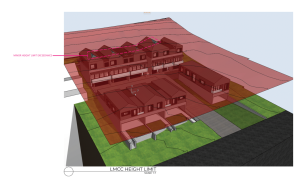The fundamental theory of CPTED is that it is possible to use knowledge and creativity to design-built environments in ways that lessen or prevent the incidence of such crime. The inclusion of CPTED Principles in the assessment of development applications has occurred across all Council within the last decade and has now become a fundamental consideration in the approval of developments. For larger scale development applications and other specific developments (such as wine bars, pubs, community facilities etc) a Crime Risk Report addressing CPTED Principles is required to be submitted.
Our team has extensive experience in the preparation of crime risk assessments, providing design advice and crime risk reports for Councils, local and State agencies and developers. Recent projects include educational facilities, sex service venues, medical centres, seniors housing, licensed premises and recreational development.
What is CPTED
Crime Prevention through Environmental Design (CPTED) is a crime prevention strategy that focuses on the planning, design and structure of cities and neighbourhoods. It reduces opportunities for crime by using design and place management principles that reduce the likelihood of essential crime ingredients (law, offender, victim or target, opportunity) from intersecting in time and space.
Predatory offenders often make cost-benefit assessment of potential victims and locations before committing crime. CPTED aims to create the reality (or perception) that the costs of committing crime are greater than the likely benefits. This is achieved by creating environmental and social conditions that:
- Maximise risk to offenders (increasing the likelihood of detection, challenge and apprehension);
- Maximise the effort required to commit crime (increasing the time, energy and resources required to commit crime);
- Minimise the actual and perceived benefits of crime (removing, minimising or concealing crime attractors and rewards); and
- Minimise excuse making opportunities (removing conditions that encourage/facilitate rationalisation of inappropriate behaviour).
CPTED employs four key strategies. These are territorial re-enforcement, surveillance, access control and space/activity management. All CPTED strategies aim to create the perception or reality of capable guardianship.
What are the CPTED Principles?
Territorial Re-enforcement
Community ownership of public space sends positive signals to the community. Places that feel owned and cared for are likely to be used, enjoyed and revisited. People who have guardianship or ownership of areas are more likely to provide effective supervision and to intervene in crime than passing strangers and criminals rarely commit crime in areas where the risk of detection and challenge are high. Effective guardians are often ordinary people who are spatially ‘connected’ to a place and feel an association with, or responsibility for it.
Territorial Re-enforcement uses actual and symbolic boundary markers, spatial legibility and environmental cues to ‘connect’ people with space, to encourage communal responsibility for public areas and facilities, and to communicate to people where they should/not be and what activities are appropriate.
Surveillance
People feel safe in public areas when they can see and interact with others, particularly people connected with that space, such as shopkeepers or adjoining residents. Criminals are often deterred from committing crime in places that are well supervised.
Natural surveillance is achieved when normal space users can see and be seen by others. This highlights the importance of building layout, orientation and location; the strategic use of design; landscaping and lighting – it is a by-product of well-planned, well-designed and well-used space.
Technical/mechanical surveillance is achieved through mechanical/electronic measures such as CCTV, help points and mirrored building panels. It is commonly used as a ‘patch’ to supervise isolated, high risk locations.
Formal (or Organised) surveillance is achieved through the tactical positioning of guardians. An example would be the use of on-site supervisors, e.g. security guards at higher risk locations.
Access Control
Access control treatments restrict, channel and encourage people and vehicles into, out of and around the development. Way-finding, desire-lines and formal/informal routes are important crime prevention considerations. Effective access control can be achieved by using physical and symbolic barriers that channel and group pedestrians into areas, therefore increasing the time and effort required for criminals to commit crime.
Natural access control includes the tactical use of landforms and waterways features, design measures including building configuration; formal and informal pathways, landscaping, fencing and gardens.
Technical/Mechanical access control includes the employment of security hardware. Crime, Design and Urban Planning: From theory to Practice Formal (or Organised) access control includes on-site guardians such as employed security officers.
Formal (or Organised) access control includes on-site guardians such as employed security officers.
Space/Activity Management
Space/Activity Management strategies are an important way to develop and maintain natural community control. Space management involves the formal supervision, control and care of the development. All space, even well planned and well-designed areas need to be effectively used and maintained to maximise community safety. Places that are infrequently used are commonly abused. There is a high correlation between urban decay, fear of crime and avoidance behaviour.
Crime Risk Report Cost
The fees for Crime Risk Reports are based on the type of development and the specific requirements of the project.
Our Crime Risk CPTED Reports start at $1,500.
Contact us for a quote for your Crime Risk Reports.






















